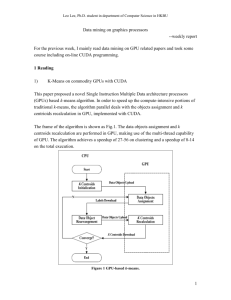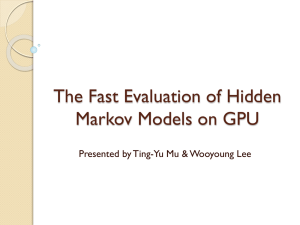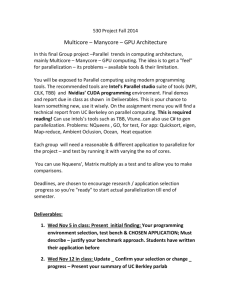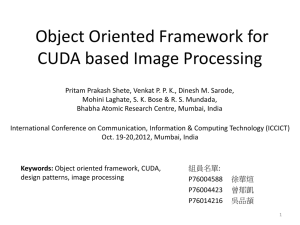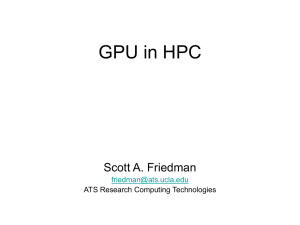Data mining on graphics processors
advertisement
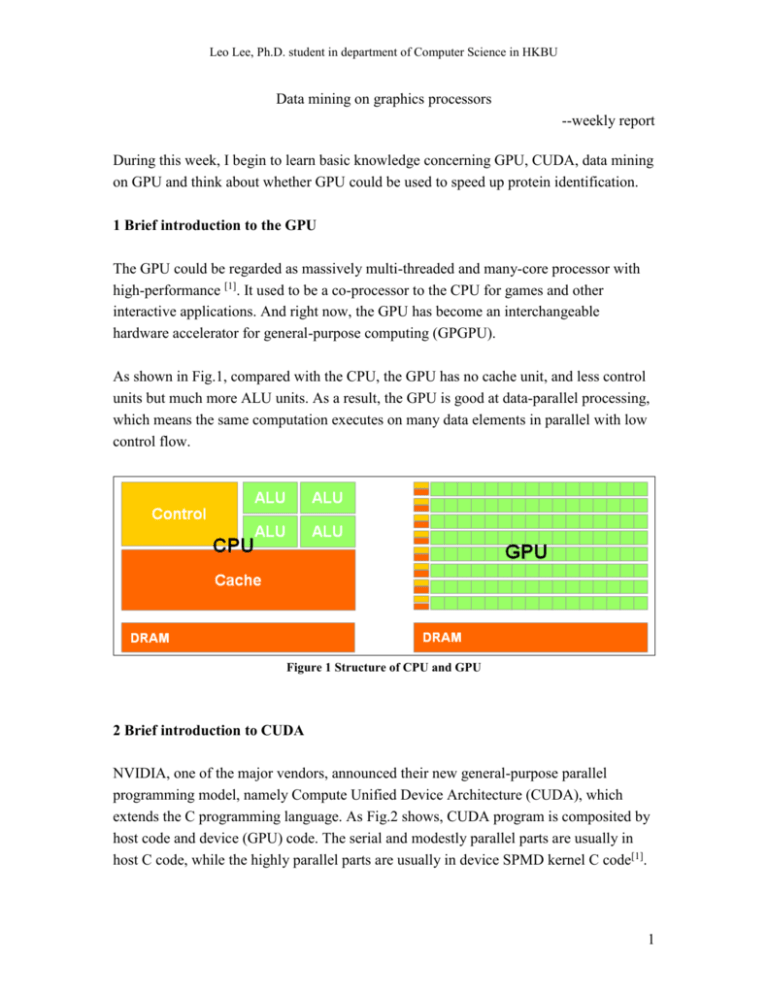
Leo Lee, Ph.D. student in department of Computer Science in HKBU Data mining on graphics processors --weekly report During this week, I begin to learn basic knowledge concerning GPU, CUDA, data mining on GPU and think about whether GPU could be used to speed up protein identification. 1 Brief introduction to the GPU The GPU could be regarded as massively multi-threaded and many-core processor with high-performance [1]. It used to be a co-processor to the CPU for games and other interactive applications. And right now, the GPU has become an interchangeable hardware accelerator for general-purpose computing (GPGPU). As shown in Fig.1, compared with the CPU, the GPU has no cache unit, and less control units but much more ALU units. As a result, the GPU is good at data-parallel processing, which means the same computation executes on many data elements in parallel with low control flow. Figure 1 Structure of CPU and GPU 2 Brief introduction to CUDA NVIDIA, one of the major vendors, announced their new general-purpose parallel programming model, namely Compute Unified Device Architecture (CUDA), which extends the C programming language. As Fig.2 shows, CUDA program is composited by host code and device (GPU) code. The serial and modestly parallel parts are usually in host C code, while the highly parallel parts are usually in device SPMD kernel C code[1]. 1 Leo Lee, Ph.D. student in department of Computer Science in HKBU The CUDA API is very lightweight, and it is an extension to the ANSI C programming language, which has a low learning curve. However, only if the developer knows the CUDA deep, including the memories, threads, application performance, float-point operations and so on, could he or she make the best use of GPU. Figure 2 CUDA program 3 k-Means on GPU k-Means is a well-known data mining algorithm for clustering, widely used in both academic research and industrial practices. k-Means iteratively computes the k centers of the input data set, where k is an input parameter. Each iteration contains mainly two steps: Step 1: divide the data set into k subsets by assigning each point to the subset whose center is the closest to the point. Step2: Recompute the k centers of each subset. The algorithm will stop when the k centers do not change any more. The process of kMeans contains lot of computing operations especially when the dimension and the data set are large. So how to speed up k-Means is a hot topic. Skadron from Uvirginia used GPU to accelerate k-Means, and got a speed-up of eight. Fang from HKUST developed GPUMiner and got a better effect. As shown in Fig.3, GPUMiner is two to five times faster than Uvirginia. Wu from hp-labs achieve an even 2 Leo Lee, Ph.D. student in department of Computer Science in HKBU better result than the former two groups, as is shown in Fig. 4, two times faster than Uvirginia and thirty to seventy times faster than GPUMiner[2, 3, 4]. Figure 3 comparison between GPUMiner and Uvirginia Figure 4 comparison between HPL, GPUMiner and Uvirginia 4 Protein identification on the GPU. 3 Leo Lee, Ph.D. student in department of Computer Science in HKBU Database searching is the choice of technique for shotgun proteomics, and till now most research effort is spent on improving its effectiveness. However, database searching is facing a serious challenge of efficiency, considering the large scale of mass spectra and the ever fast increasing of protein and peptide databases resulting from genome translations, enzymatic digestions, and post-translational modifications. On the other hand, the GPU is widely used for high performance computing, so whether the GPU could accelerate protein identification is worth to think about. The characters of identification flow decide if the GPU is suitable. As is shown in Fig. 5, the identification mainly contains three steps: Step 1: digest protein sequences into peptides, remove the redundant peptides then sort them according to the mass. Step 2: for each peptide, generate all the PTM peptides; for each PTM peptide, query the corresponding spectra. Step 3: for each pair of PTM peptide and the spectrum, computer the similarity score, and save the top-ten score. Figure 5 Protein identification flow 4 Leo Lee, Ph.D. student in department of Computer Science in HKBU For each score, the main computing operation is named Matching, which costs half of the total identification time. We can represent a peptide as a vector P (a1, a2, a3,…, am), and represent a spectrum as a vector S (b1, b2, b3,…, bn). During the Matching, for each ai in P, find out whether it exists in S and keep the result in another vector for further score. From the identification flow, there are two initial ideas. The first one is applying the GPU to the Matching process. Each thread in GPU is in charge of a pair of peptide-spectrum match, or each block takes charge of a pair of peptide-spectrum match and each thread works on a query. The second one is each block takes charge of a digest peptide, and each thread takes charge of a PTM peptide, including match and score. The second idea seems to be more parallel than the first one. However, there are still difficulties to be solved. Each thread is in charge of one PTM peptide, and different peptides would score with the same spectrum and keep the results. Consequently, threads from different block would write the same memory for score results and need atomic operation, which would decrease the speed-up effect. In summary, whether GPU could be used in protein identification and how to use it still need further research. 5 research plan 1) Read related papers a. GPU, data mining, bioinformatics; b. At least one paper each day; 2) Listen to the on-line class about CUDA a. One class each day; b. Do the experiment. 3) Read our k-means code and try to speed it up a. Learn from Kaiyong and discuss with him more 4) Try protein identification on GPU 6 References [1] http://cuda.csdn.net/zxkt/index.html [2] A Performance Study of General-Purpose Application on Graphics Processors Using CUDA. S. Che et al, J. Parallel-Distrib. Comput. 2008. 5 Leo Lee, Ph.D. student in department of Computer Science in HKBU [3] Parallel Data Mining on Graphics Processors. W. Fang et al. Technical Report HKUST-CS0807, Oct 2008. [4] GPU-Accelerated Large Scale Analytics. R. Wu et al, HP Laboratories. 2009 6
